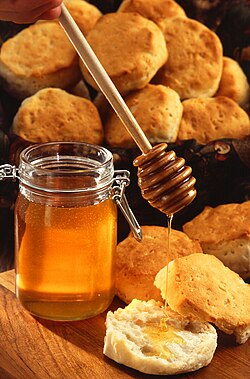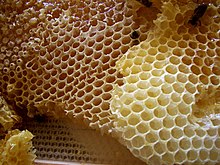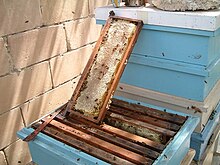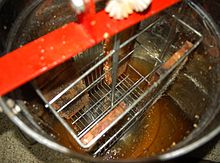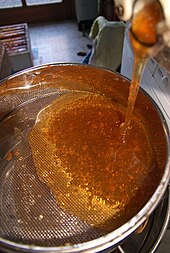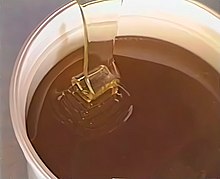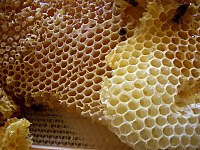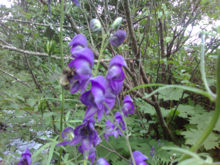Honey is a sweet, viscous food substance made by honey bees and some related insects. Bees produce honey from the sugary secretions of plants (floral nectar) or from secretions of other insects (such as honeydew), by regurgitation, enzymatic activity, and water evaporation. Bees store honey in wax structures called honeycombs. The variety of honey produced by honey bees (the genus Apis) is the best-known, due to its worldwide commercial production and human consumption. Honey is collected from wild bee colonies, or from hives of domesticated bees, a practice known as beekeeping or apiculture.
Honey gets its sweetness from the monosaccharides fructose and glucose, and has about the same relative sweetness as sucrose (table sugar). Fifteen millilitres (1 US tablespoon) of honey provides around 190 kilojoules (46 kilocalories) of food energy. It has attractive chemical properties for baking and a distinctive flavor when used as a sweetener. Most microorganisms do not grow in honey, so sealed honey does not spoil, even after thousands of years.
Honey use and production have a long and varied history as an ancient activity. Several cave paintings in Cuevas de la Araña in Spain depict humans foraging for honey at least 8,000 years ago.
Formation
Honey is produced by bees collecting nectar and honeydew for use as sugars consumed to support metabolism of muscle activity during foraging or to be stored as a long-term food supply. During foraging, bees access part of the nectar collected to support metabolic activity of flight muscles, with the majority of collected nectar destined for regurgitation, digestion, and storage as honey. In cold weather or when other food sources are scarce, adult and larval bees use stored honey as food.
By contriving for bee swarms to nest in human-made hives, people have been able to semidomesticate the insects and harvest excess honey. In the hive or in a wild nest, the three types of bees are:
- a single female queen bee
- a seasonally variable number of male drone bees to fertilize new queens
- 20,000 to 40,000 female worker bees
Leaving the hive, a foraging bee collects sugar-rich flower nectar, sucking it through its proboscis and placing it in its proventriculus (honey stomach or crop), which lies just dorsal to its food stomach. The honey stomach holds about 40 mg of nectar, or roughly 50% of the bee's unloaded weight, which can require over a thousand flowers and more than an hour to fill. The nectar generally begins with a water content of 70 to 80%. Salivary enzymes and proteins from the bee's hypopharyngeal gland are added to the nectar to begin breaking down the sugars, raising the water content slightly. The forager bees then return to the hive, where they regurgitate and transfer nectar to the hive bees. The hive bees then use their honey stomachs to ingest and regurgitate the nectar, forming bubbles between their mandibles repeatedly until it is partially digested. The bubbles create a large surface area per volume and a portion of the water is removed through evaporation. The bee's digestive enzymes hydrolyze converts sucrose to a mixture of glucose and fructose, and break down other starches and proteins, increasing the acidity.
The bees work together as a group with the regurgitation and digestion for as long as 20 minutes, passing the nectar from one bee to the next, until the product reaches the honeycombs in storage quality. It is then placed in honeycomb cells and left unsealed while still high in water content (about 50 to 70%) and natural yeasts which, unchecked, would cause the sugars in the newly formed honey to ferment. Bees are among the few insects that can generate large amounts of body heat, and the hive bees constantly regulate the hive temperature, either heating with their bodies or cooling with water evaporation, to maintain a fairly constant temperature of about 35 °C (95 °F) in the honey-storage areas. The process continues as hive bees flutter their wings constantly to circulate air and evaporate water from the honey to a content around 18%, raising the sugar concentration beyond the saturation point and preventing fermentation. The bees then cap the cells with wax to seal them. As removed from the hive by a beekeeper, honey has a long shelf life and will not ferment if properly sealed.
Some wasp species, such as Brachygastra lecheguana and Brachygastra mellifica found in South and Central America, are known to feed on nectar and produce honey.
Some wasps, such as Polistes versicolor, consume honey, alternating between feeding on pollen in the middle of their lifecycles and feeding on honey, which can better provide for their energy needs.
Production
Collection
Honey is collected from wild bee colonies or from domesticated beehives. On average, a hive will produce about 29 kilograms (65 lb) of honey per year. Wild bee nests are sometimes located by following a honeyguide bird.
To safely collect honey from a hive, beekeepers typically pacify the bees using a bee smoker. The smoke triggers a feeding instinct (an attempt to save the resources of the hive from a possible fire), making them less aggressive, and obscures the pheromones the bees use to communicate. The honeycomb is removed from the hive and the honey may be extracted from it either by crushing or by using a honey extractor. The honey is then usually filtered to remove beeswax and other debris.
Before the invention of removable frames, bee colonies were often sacrificed to conduct the harvest. The harvester would take all the available honey and replace the entire colony the next spring. Since the invention of removable frames, the principles of husbandry led most beekeepers to ensure that their bees have enough stores to survive the winter, either by leaving some honey in the beehive or by providing the colony with a honey substitute such as sugar water or crystalline sugar (often in the form of a "candyboard"). The amount of food necessary to survive the winter depends on the variety of bees and on the length and severity of local winters.
Many animal species are attracted to wild or domestic sources of honey.
Preservation
Because of its composition and chemical properties, honey is suitable for long-term storage, and is easily assimilated even after long preservation. Honey, and objects immersed in honey, have been preserved for centuries. The key to preservation is limiting access to humidity. In its cured state, honey has a sufficiently high sugar content to inhibit fermentation. If exposed to moist air, its hydrophilic properties pull moisture into the honey, eventually diluting it to the point that fermentation can begin.
The long shelf life of honey is attributed to an enzyme found in the stomach of bees. The bees mix glucose oxidase with expelled nectar they previously consumed, creating two byproducts – gluconic acid and hydrogen peroxide, which are partially responsible for honey acidity and suppression of bacterial growth.
Adulteration
Honey is sometimes adulterated by the addition of other sugars, syrups, or compounds to change its flavor or viscosity, reduce cost, or increase the fructose content to stave off crystallization. Adulteration of honey has been practiced since ancient times, when honey was sometimes blended with plant syrups such as maple, birch, or sorghum and sold to customers as pure honey. Sometimes crystallized honey was mixed with flour or other fillers, hiding the adulteration from buyers until the honey was liquefied. In modern times the most common adulterant became clear, almost-flavorless corn syrup; the adulterated mixture can be very difficult to distinguish from pure honey.
According to the Codex Alimentarius of the United Nations, any product labeled as "honey" or "pure honey" must be a wholly natural product, although labeling laws differ between countries. In the United States, according to the National Honey Board (NHB; supervised by the United States Department of Agriculture), "honey stipulates a pure product that does not allow for the addition of any other substance... this includes, but is not limited to, water or other sweeteners".
Isotope ratio mass spectrometry can be used to detect addition of corn syrup and cane sugar by the carbon isotopic signature. Addition of sugars originating from corn or sugar cane (C4 plants, unlike the plants used by bees, and also sugar beet, which are predominantly C3 plants) skews the isotopic ratio of sugars present in honey, but does not influence the isotopic ratio of proteins. In an unadulterated honey, the carbon isotopic ratios of sugars and proteins should match. Levels as low as 7% of addition can be detected.
Worldwide production
| Country | Production (tonnes) |
|---|---|
In 2019, global production of honey was 1.9 million tonnes, led by China with 24% of the world total (table). Other major producers were Turkey, Canada, Argentina, and Iran.
Modern uses
Food
Over its history as a food, the main uses of honey are in cooking, baking, desserts, as a spread on bread, as an addition to various beverages such as tea, and as a sweetener in some commercial beverages.
Due to its energy density, honey is an important food for virtually all hunter-gatherer cultures in warm climates, with the Hadza people
ranking honey as their favorite food.
Fermentation
Possibly the world's oldest fermented beverage, dating from 9,000 years ago, mead ("honey wine") is the alcoholic product made by adding yeast to honey-water must and fermenting it for weeks or months. The yeast Saccharomyces cerevisiae is commonly used in modern mead production. Mead varieties include drinks called metheglin (with spices or herbs), melomel (with fruit juices, such as grape, specifically called pyment), hippocras (with cinnamon), and sack mead (high concentration of honey), many of which have been developed as commercial products numbering in the hundreds in the United States. Honey is also used to make mead beer, called "braggot".
Physical and chemical properties
The physical properties of honey vary, depending on water content, the type of flora used to produce it (pasturage), temperature, and the proportion of the specific sugars it contains. Fresh honey is a supersaturated liquid, containing more sugar than the water can typically dissolve at ambient temperatures. At room temperature, honey is a supercooled liquid, in which the glucose precipitates into solid granules. This forms a semisolid solution of precipitated glucose crystals in a solution of fructose and other ingredients.
The density of honey typically ranges between 1.38 and 1.45 kg/l at 20 °C.
Phase transitions
The melting point of crystallized honey is between 40 and 50 °C (104 and 122 °F), depending on its composition. Below this temperature, honey can be either in a metastable state, meaning that it will not crystallize until a seed crystal is added, or, more often, it is in a "labile" state, being saturated with enough sugars to crystallize spontaneously. The rate of crystallization is affected by many factors, but the primary factor is the ratio of the main sugars: fructose to glucose. Honeys that are supersaturated with a very high percentage of glucose, such as brassica honey, crystallize almost immediately after harvesting, while honeys with a low percentage of glucose, such as chestnut or tupelo honey, do not crystallize. Some types of honey may produce few but very large crystals, while others produce many small crystals.
Crystallization is also affected by water content, because a high percentage of water inhibits crystallization, as does a high dextrin content. Temperature also affects the rate of crystallization, with the fastest growth occurring between 13 and 17 °C (55 and 63 °F). Crystal nuclei (seeds) tend to form more readily if the honey is disturbed, by stirring, shaking, or agitating, rather than if left at rest. However, the nucleation of microscopic seed-crystals is greatest between 5 and 8 °C (41 and 46 °F). Therefore, larger but fewer crystals tend to form at higher temperatures, while smaller but more-numerous crystals usually form at lower temperatures. Below 5 °C, the honey will not crystallize, thus the original texture and flavor can be preserved indefinitely.
Honey is a supercooled liquid when stored below its melting point, as is normal. At very low temperatures, honey does not freeze solid; rather its viscosity increases. Like most viscous liquids, the honey becomes thick and sluggish with decreasing temperature. At −20 °C (−4 °F), honey may appear or even feel solid, but it continues to flow at very low rates. Honey has a glass transition between −42 and −51 °C (−44 and −60 °F). Below this temperature, honey enters a glassy state and becomes an amorphous solid (noncrystalline).
Rheology
The viscosity of honey is affected greatly by both temperature and water content. The higher the water percentage, the more easily honey flows. Above its melting point, however, water has little effect on viscosity. Aside from water content, the composition of most types of honey also has little effect on viscosity. At 25 °C (77 °F), honey with 14% water content generally has a viscosity around 400 poise, while a honey containing 20% water has a viscosity around 20 poise. Viscosity increases very slowly with moderate cooling; a honey containing 16% water, at 70 °C (158 °F), has a viscosity around 2 poise, while at 30 °C (86 °F), the viscosity is around 70 poise. With further cooling, the increase in viscosity is more rapid, reaching 600 poise at around 14 °C (57 °F). However, while honey is viscous, it has low surface tension of 50–60 mJ/m2, making its wettability similar to water, glycerin, or most other liquids. The high viscosity and wettability of honey cause stickiness, which is a time-dependent process in supercooled liquids between the glass-transition temperature (Tg) and the crystalline-melting temperature.
Most types of honey are Newtonian liquids, but a few types have non-Newtonian viscous properties. Honeys from heather or manuka display thixotropic properties. These types of honey enter a gel-like state when motionless, but liquefy when stirred.
Electrical and optical properties
Because honey contains electrolytes, in the form of acids and minerals, it exhibits varying degrees of electrical conductivity. Measurements of the electrical conductivity are used to determine the quality of honey in terms of ash content.
The effect honey has on light is useful for determining the type and quality. Variations in its water content alter its refractive index. Water content can easily be measured with a refractometer. Typically, the refractive index for honey ranges from 1.504 at 13% water content to 1.474 at 25%. Honey also has an effect on polarized light, in that it rotates the polarization plane. The fructose gives a negative rotation, while the glucose gives a positive one. The overall rotation can be used to measure the ratio of the mixture. Honey may vary in color between pale yellow and dark brown, but other bright colors may occasionally be found, depending on the source of the sugar harvested by the bees.
Hygroscopy and fermentation
Honey has the ability to absorb moisture directly from the air, a phenomenon called hygroscopy. The amount of water the honey absorbs is dependent on the relative humidity of the air. Because honey contains yeast, this hygroscopic nature requires that honey be stored in sealed containers to prevent fermentation, which usually begins if the honey's water content rises much above 25%. Honey tends to absorb more water in this manner than the individual sugars allow on their own, which may be due to other ingredients it contains.
Fermentation of honey usually occurs after crystallization, because without the glucose, the liquid portion of the honey primarily consists of a concentrated mixture of fructose, acids, and water, providing the yeast with enough of an increase in the water percentage for growth. Honey that is to be stored at room temperature for long periods of time is often pasteurized, to kill any yeast, by heating it above 70 °C (158 °F).
Thermal characteristics
Like all sugar compounds, honey caramelizes if heated sufficiently, becoming darker in color, and eventually burns. However, honey contains fructose, which caramelizes at lower temperatures than glucose. The temperature at which caramelization begins varies, depending on the composition, but is typically between 70 and 110 °C (158 and 230 °F). Honey also contains acids, which act as catalysts for caramelization. The specific types of acids and their amounts play a primary role in determining the exact temperature. Of these acids, the amino acids, which occur in very small amounts, play an important role in the darkening of honey. The amino acids form darkened compounds called melanoidins, during a Maillard reaction. The Maillard reaction occurs slowly at room temperature, taking from a few to several months to show visible darkening, but speeds up dramatically with increasing temperatures. However, the reaction can also be slowed by storing the honey at colder temperatures.
Unlike many other liquids, honey has very poor thermal conductivity of 0.5 W/(m⋅K) at 13% water content (compared to 401 W/(m⋅K) of copper), taking a long time to reach thermal equilibrium. Due to its high kinematic viscosity honey does not transfer heat through momentum diffusion (convection) but rather through thermal diffusion (more like a solid), so melting crystallized honey can easily result in localized caramelization if the heat source is too hot or not evenly distributed. However, honey takes substantially longer to liquefy when just above the melting point than at elevated temperatures. Melting 20 kg of crystallized honey at 40 °C (104 °F) can take up to 24 hours, while 50 kg may take twice as long. These times can be cut nearly in half by heating at 50 °C (122 °F); however, many of the minor substances in honey can be affected greatly by heating, changing the flavor, aroma, or other properties, so heating is usually done at the lowest temperature and for the shortest time possible.
Acid content and flavor effects
The average pH of honey is 3.9, but can range from 3.4 to 6.1. Honey contains many kinds of acids, both organic and amino. However, the different types and their amounts vary considerably, depending on the type of honey. These acids may be aromatic or aliphatic (nonaromatic). The aliphatic acids contribute greatly to the flavor of honey by interacting with the flavors of other ingredients.
Organic acids comprise most of the acids in honey, accounting for 0.17–1.17% of the mixture, with gluconic acid formed by the actions of glucose oxidase as the most prevalent. Minor amounts of other organic acids are present, consisting of formic, acetic, butyric, citric, lactic, malic, pyroglutamic, propionic, valeric, capronic, palmitic, and succinic, among many others.
Volatile organic compounds
Individual honeys from different plant sources contain over 100 volatile organic compounds (VOCs), which play a primary role in determining honey flavors and aromas. VOCs are carbon-based compounds that readily vaporize into the air, providing aroma, including the scents of flowers, essential oils, or ripening fruit. The typical chemical families of VOCs found in honey include hydrocarbons, aldehydes, alcohols, ketones, esters, acids, benzenes, furans, pyrans, norisoprenoids, and terpenes, among many others and their derivatives. The specific VOCs and their amounts vary considerably between different types of honey obtained by bees foraging on different plant sources. By example, when comparing the mixture of VOCs in different honeys in one review, longan honey had a higher amount of volatiles (48 VOCs), while sunflower honey had the lowest number of volatiles (8 VOCs).
VOCs are primarily introduced into the honey from the nectar, where they are excreted by the flowers imparting individual scents. The specific types and concentrations of certain VOCs can be used to determine the type of flora used to produce monofloral honeys. The specific geography, soil composition and acidity used to grow the flora also have an effect on honey aroma properties, such as a "fruity" or "grassy" aroma from longan honey, or a "waxy" aroma from sunflower honey. Dominant VOCs in one study were linalool oxide, trans-linalool oxide, 2-phenylacetaldehyde, benzyl ethanol, isophorone, and methyl nonanoate.
VOCs can also be introduced from the bodies of the bees, be produced by the enzymatic actions of digestion, or from chemical reactions that occur between different substances within the honey during storage, and therefore may change, increase, or decrease over long periods of time. VOCs may be produced, altered, or greatly affected by temperature and processing. Some VOCs are heat labile, and are destroyed at elevated temperatures, while others can be created during non-enzymatic reactions, such as the Maillard reaction. VOCs are responsible for nearly all of the aroma produced by a honey, which may be described as "sweet", "flowery", "citrus", "almond" or "rancid", among other terms. In addition, VOCs play a large role in determining the specific flavor of the honey, both through the aromas and flavor. VOCs from honeys in different geographic regions can be used as floral markers of those regions, and as markers of the bees that foraged the nectars.
Classification
Honey is classified by its floral source, and divisions are made according to the packaging and processing used. Regional honeys are also identified. In the USA, honey is also graded on its color and optical density by USDA standards, graded on the Pfund scale, which ranges from 0 for "water white" honey to more than 114 for "dark amber" honey.
Floral source
Generally, honey is classified by the floral source of the nectar from which it was made. Honeys can be from specific types of flower nectars or can be blended after collection. The pollen in honey is traceable to floral source and therefore region of origin. The rheological and melissopalynological properties of honey can be used to identify the major plant nectar source used in its production.
Blended
Most commercially available honey is a blend of two or more honeys differing in floral source, color, flavor, density, or geographic origin.
Polyfloral
Polyfloral honey, also known as wildflower honey, is derived from the nectar of many types of flowers. The taste may vary from year to year, and the aroma and the flavor can be more or less intense, depending on which flowers are blooming.
Monofloral
Monofloral honey is made primarily from the nectar of one type of flower. Monofloral honeys have distinctive flavors and colors because of differences between their principal nectar sources. To produce monofloral honey, beekeepers keep beehives in an area where the bees have access, as far as possible, to only one type of flower. In practice a small proportion of any monofloral honey will be from other flower types. Typical examples of North American monofloral honeys are clover, orange blossom, sage, tupelo, buckwheat, fireweed, mesquite, sourwood, cherry, and blueberry. Some typical European examples include thyme, thistle, heather, acacia, dandelion, sunflower, lavender, honeysuckle, and varieties from lime and chestnut trees. In North Africa (e.g. Egypt), examples include clover, cotton, and citrus (mainly orange blossoms). The unique flora of Australia yields a number of distinctive honeys, with some of the most popular being yellow box, blue gum, ironbark, bush mallee, Tasmanian leatherwood, and macadamia.
Honeydew honey
Instead of taking nectar, bees can take honeydew, the sweet secretions of aphids or other plant-sap-sucking insects. Honeydew honey is very dark brown, with a rich fragrance of stewed fruit or fig jam, and is not as sweet as nectar honeys. Germany's Black Forest is a well-known source of honeydew-based honeys, as are some regions in Bulgaria, Tara in Serbia, and Northern California in the United States. In Greece pine honey, a type of honeydew honey, constitutes 60–65% of honey production. Honeydew honey is popular in some areas, but in other areas, beekeepers have difficulty selling honeydew honey, due to its stronger flavor.
The production of honeydew honey has some complications and dangers. This honey has a much larger proportion of indigestibles than light floral honeys, thus causing dysentery to the bees, resulting in the death of colonies in areas with cold winters. Good beekeeping management requires the removal of honeydew prior to winter in colder areas. Bees collecting this resource also have to be fed protein supplements, as honeydew lacks the protein-rich pollen accompaniment gathered from flowers.
Honeydew honey is sometimes called "myelate".
Classification by packaging and processing
Generally, honey is bottled in its familiar liquid form, but it is sold in other forms, and can be subjected to a variety of processing methods.
- Crystallized honey occurs when some of the glucose content has spontaneously crystallized from solution as the monohydrate. It is also called "granulated honey" or "candied honey". Honey that has crystallized (or is commercially purchased crystallized) can be returned to a liquid state by warming.
- Pasteurized honey has been heated in a pasteurization process which requires temperatures of 72 °C (161 °F) or higher. Pasteurization destroys yeast cells. It also liquefies any microcrystals in the honey, which delays the onset of visible crystallization. However, excessive heat exposure also results in product deterioration, as it increases the level of hydroxymethylfurfural (HMF) and reduces enzyme (e.g. diastase) activity. Heat also darkens the honey, and affects taste and fragrance.
- Raw honey is as it exists in the beehive or as obtained by extraction, settling, or straining, without adding heat (although some honey that has been "minimally processed" is often labeled as raw honey). Raw honey contains some pollen and may contain small particles of wax.
- Strained honey has been passed through a mesh material to remove particulate material (pieces of wax, propolis, other defects) without removing pollen, minerals, or enzymes.
- Filtered honey of any type has been filtered to the extent that all or most of the fine particles, pollen grains, air bubbles, or other materials normally found in suspension, have been removed. The process typically heats honey to 66–77 °C (150–170 °F) to more easily pass through the filter. Filtered honey is very clear and will not crystallize as quickly, making it preferred by supermarkets. The most common method involves the addition of diatomaceous earth to honey that is heated to 60 °C (140 °F) and passed through filter paper or canvas until a filter cake of diatomaceous earth builds up on the filter.
- Ultrasonicated honey has been processed by ultrasonication, a nonthermal processing alternative for honey. When honey is exposed to ultrasonication, most of the yeast cells are destroyed. Those cells that survive sonication generally lose their ability to grow, which reduces the rate of honey fermentation substantially. Ultrasonication also eliminates existing crystals and inhibits further crystallization in honey. Ultrasonically aided liquefaction can work at substantially lower temperatures around 35 °C (95 °F) and can reduce liquefaction time to less than 30 seconds.
- Creamed honey, also called whipped honey, spun honey, churned honey, honey fondant, and, in the UK, set honey, has been processed to control crystallization. Creamed honey contains a large number of small crystals, which prevent the formation of larger crystals that can occur in unprocessed honey. The processing also produces a honey with a smooth, spreadable consistency.
- Dried honey has the moisture extracted from liquid honey to create completely solid, nonsticky granules. This process may or may not include the use of drying and anticaking agents. Dried honey is used in baked goods, and to garnish desserts.
- Comb honey is still in the honeybees' wax comb. It is traditionally collected using standard wooden frames in honey supers. The frames are collected and the comb is cut out in chunks before packaging. As an alternative to this labor-intensive method, plastic rings or cartridges can be used that do not require manual cutting of the comb, and speed packaging. Comb honey harvested in the traditional manner is also referred to as "cut-comb honey".
- Chunk honey is packed in wide-mouthed containers; it consists of one or more pieces of comb honey immersed in extracted liquid honey.
- Honey decoctions are made from honey or honey byproducts which have been dissolved in water, then reduced (usually by means of boiling). Other ingredients may then be added. (For example, abbamele has added citrus.) The resulting product may be similar to molasses.
- Baker's honey is outside the normal specification for honey, due to a "foreign" taste or odor, or because it has begun to ferment or has been overheated. It is generally used as an ingredient in food processing. Additional requirements exist for labeling baker's honey, including that it may not be sold labeled simply as "honey".
Grading
Countries have differing standards for grading honey. In the US, honey grading is performed voluntarily based upon USDA standards. USDA offers inspection and grading "as on-line (in-plant) or lot inspection...upon application, on a fee-for-service basis." Honey is graded based upon a number of factors, including water content, flavor and aroma, absence of defects, and clarity. Honey is also classified by color, though it is not a factor in the grading scale. The honey grade scale is:
| Grade | Soluble solids | Flavor and aroma | Absence of defects | Clarity |
|---|---|---|---|---|
| A | ≥ 81.4% | Good—"has a good, normal flavor and aroma for the predominant floral source or, when blended, a good flavor for the blend of floral sources and the honey is free from caramelized flavor or objectionable flavor caused by fermentation, smoke, chemicals, or other causes with the exception of the predominant floral source" | Practically free—"contains practically no defects that affect the appearance or edibility of the product" | Clear—"may contain air bubbles which do not materially affect the appearance of the product and may contain a trace of pollen grains or other finely divided particles of suspended material which do not affect the appearance of the product" |
| B | ≥ 81.4% | Reasonably good—"has a reasonably good, normal flavor and aroma for the predominant floral source or, when blended, a reasonably good flavor for the blend of floral sources and the honey is practically free from caramelized flavor and is free from objectionable flavor caused by fermentation, smoke, chemicals, or other causes with the exception of the predominant floral source" | Reasonably free—"may contain defects which do not materially affect the appearance or edibility of the product" | Reasonably clear—"may contain air bubbles, pollen grains, or other finely divided particles of suspended material which do not materially affect the appearance of the product" |
| C | ≥ 80.0% | Fairly good—"has a fairly good, normal flavor and aroma for the predominant floral source or, when blended, a fairly good flavor for the blend of floral sources and the honey is reasonably free from caramelized flavor and is free from objectionable flavor caused by fermentation, smoke, chemicals, or other causes with the exception of the predominant floral source" | Fairly free—"may contain defects which do not seriously affect the appearance or edibility of the product" | Fairly clear—"may contain air bubbles, pollen grains, or other finely divided particles of suspended material which do not seriously affect the appearance of the product" |
| Substandard | Fails Grade C | Fails Grade C | Fails Grade C | Fails Grade C |
India certifies honey grades based on additional factors, such as the Fiehe's test, and other empirical measurements.
Indicators of quality
High-quality honey can be distinguished by fragrance, taste, and consistency. Ripe, freshly collected, high-quality honey at 20 °C (68 °F) should flow from a knife in a straight stream, without breaking into separate drops. After falling down, the honey should form a bead. The honey, when poured, should form small, temporary layers that disappear fairly quickly, indicating high viscosity. If not, it indicates honey with excessive water content of over 20%, not suitable for long-term preservation.
In jars, fresh honey should appear as a pure, consistent fluid, and should not set in layers. Within a few weeks to a few months of extraction, many varieties of honey crystallize into a cream-colored solid. Some varieties of honey, including tupelo, acacia, and sage, crystallize less regularly. Honey may be heated during bottling at temperatures of 40–49 °C (104–120 °F) to delay or inhibit crystallization. Overheating is indicated by change in enzyme levels, for instance, diastase activity, which can be determined with the Schade or the Phadebas methods. A fluffy film on the surface of the honey (like a white foam), or marble-colored or white-spotted crystallization on a container's sides, is formed by air bubbles trapped during the bottling process.
A 2008 Italian study determined that nuclear magnetic resonance spectroscopy can be used to distinguish between different honey types, and can be used to pinpoint the area where it was produced. Researchers were able to identify differences in acacia and polyfloral honeys by the differing proportions of fructose and sucrose, as well as differing levels of aromatic amino acids phenylalanine and tyrosine. This ability allows greater ease of selecting compatible stocks.
Nutrition
| Nutritional value per 100 g (3.5 oz) | |
|---|---|
| Energy | 1,272 kJ (304 kcal) |
82.4 g | |
| Sugars | 82.12 g |
| Dietary fiber | 0.2 g |
0 g | |
0.3 g | |
| Vitamins | Quantity %DV† |
| Riboflavin (B2) | 3% 0.038 mg |
| Niacin (B3) | 1% 0.121 mg |
| Pantothenic acid (B5) | 1% 0.068 mg |
| Vitamin B6 | 2% 0.024 mg |
| Folate (B9) | 1% 2 μg |
| Vitamin C | 1% 0.5 mg |
| Minerals | Quantity %DV† |
| Calcium | 1% 6 mg |
| Iron | 3% 0.42 mg |
| Magnesium | 1% 2 mg |
| Phosphorus | 1% 4 mg |
| Potassium | 1% 52 mg |
| Sodium | 0% 4 mg |
| Zinc | 2% 0.22 mg |
| Other constituents | Quantity |
| Water | 17.10 g |
| |
| †Percentages are roughly approximated using US recommendations for adults. | |
One hundred grams of honey provides about 1,270 kJ (304 kcal) of energy with no significant amounts of essential nutrients. Composed of 17% water and 82% carbohydrates, honey has low content of fat, dietary fiber, and protein.
Sugar profile
A mixture of sugars and other carbohydrates, honey is mainly fructose (about 38%) and glucose (about 32%), with remaining sugars including maltose, sucrose, and other complex carbohydrates. Its glycemic index ranges from 31 to 78, depending on the variety. The specific composition, color, aroma, and flavor of any batch of honey depend on the flowers foraged by bees that produced the honey.
One 1980 study found that mixed floral honey from several United States regions typically contains the following:
- Fructose: 38.2%
- Glucose: 31.3%
- Maltose: 7.1%
- Sucrose: 1.3%
- Water: 17.2%
- Higher sugars: 1.5%
- Ash: 0.2%
- Other/undetermined: 3.2%
A 2013 NMR spectroscopy study of 20 different honeys from Germany found that their sugar contents comprised:
- Fructose: 28% to 41%
- Glucose: 22% to 35%
The average ratio was 56% fructose to 44% glucose, but the ratios in the individual honeys ranged from a high of 64% fructose and 36% glucose (one type of flower honey; table 3 in reference) to a low of 50% fructose and 50% glucose (a different floral source). This NMR method was not able to quantify maltose, galactose, and the other minor sugars as compared to fructose and glucose.
Medical use and research
Wounds and burns
Honey is a popular folk treatment for burns and other skin injuries. Preliminary evidence suggests that it aids in the healing of partial thickness burns 4–5 days faster than other dressings, and moderate evidence suggests that post-operative infections treated with honey heal faster and with fewer adverse events than with antiseptic and gauze. The evidence for the use of honey in various other wound treatments is of low quality, and firm conclusions cannot be drawn. Evidence does not support the use of honey-based products for the treatment of venous stasis ulcers or ingrown toenail. Several medical-grade honey products have been approved by the FDA for use in treating minor wounds and burns.
Antibiotic
Honey has long been used as a topical antibiotic by practitioners of traditional and herbal medicine. Honey's antibacterial effects were first demonstrated by the Dutch scientist Bernardus Adrianus van Ketel in 1892. Since then, numerous studies have shown that honey has broad-spectrum antibacterial activity against Gram-positive and Gram-negative bacteria, although potency varies widely between different honeys. Due to the proliferation of antibiotic-resistant bacteria in the last few decades, there has been renewed interest in researching the antibacterial properties of honey. Components of honey under preliminary research for potential antibiotic use include methylglyoxal, hydrogen peroxide, and royalisin (also called defensin-1).
Cough
For chronic and acute coughs, a Cochrane review found no strong evidence for or against the use of honey. For treating children, the systematic review concluded with moderate to low evidence that honey probably helps more than no treatment, diphenhydramine, and placebo at giving relief from coughing. Honey does not appear to work better than dextromethorphan at relieving coughing in children. Another reviewer agrees with these conclusions.
The UK Medicines and Healthcare products Regulatory Agency recommends avoiding giving over-the-counter cough and common cold medication to children under six, and suggests "a homemade remedy containing honey and lemon is likely to be just as useful and safer to take", but warns that honey should not be given to babies because of the risk of infant botulism. The World Health Organization recommends honey as a treatment for coughs and sore throats, including for children, stating that no reason exists to believe it is less effective than a commercial remedy.
Other
The use of honey has been recommended as a temporary intervention for known or suspected button cell battery ingestions to reduce the risk and severity of injury to the esophagus caused by the battery prior to its removal.
There is no evidence that honey is beneficial for treating cancer, although honey may be useful for controlling side effects of radiation therapy or chemotherapy used to treat cancer.
Consumption is sometimes advocated as a treatment for seasonal allergies due to pollen, but scientific evidence to support the claim is inconclusive. Honey is generally considered ineffective for the treatment of allergic conjunctivitis.
Although the majority of calories in honey is from fructose, honey does not cause increased weight gain and fructose by itself is not an independent factor for weight gain. Health hazards
Honey is generally safe when taken in typical food amounts, but it may have various, potential adverse effects or interactions in combination with excessive consumption, existing disease conditions, or drugs. Included among these are mild reactions to high intake, such as anxiety, insomnia, or hyperactivity in about 10% of children, according to one study. No symptoms of anxiety, insomnia, or hyperactivity were detected with honey consumption compared to placebo, according to another study. Honey consumption may interact adversely with existing allergies, high blood sugar levels (as in diabetes), or anticoagulants used to control bleeding, among other clinical conditions.
People who have a weakened immune system may be at risk of bacterial or fungal infection from eating honey.
Botulism
Infants can develop botulism after consuming honey contaminated with Clostridium botulinum endospores.
Infantile botulism shows geographical variation. In the UK, only six cases were reported between 1976 and 2006, yet the U.S. has much higher rates: 1.9 per 100,000 live births, 47.2% of which are in California. While the risk honey poses to infant health is small, taking the risk is not recommended until after one year of age, and then giving honey is considered safe.
Toxic honey
Mad honey intoxication is a result of eating honey containing grayanotoxins. Honey produced from flowers of rhododendrons, mountain laurels, sheep laurel, and azaleas may cause honey intoxication. Symptoms include dizziness, weakness, excessive perspiration, nausea, and vomiting. Less commonly, low blood pressure, shock, heart rhythm irregularities, and convulsions may occur, with rare cases resulting in death. Honey intoxication is more likely when using "natural" unprocessed honey and honey from farmers who may have a small number of hives. Commercial processing, with pooling of honey from numerous sources, is thought to dilute any toxins.
Toxic honey may also result when bees are proximate to tutu bushes (Coriaria arborea) and the vine hopper insect (Scolypopa australis). Both are found throughout New Zealand. Bees gather honeydew produced by the vine hopper insects feeding on the tutu plant. This introduces the poison tutin into honey. Only a few areas in New Zealand (the Coromandel Peninsula, Eastern Bay of Plenty and the Marlborough Sounds) frequently produce toxic honey. Symptoms of tutin poisoning include vomiting, delirium, giddiness, increased excitability, stupor, coma, and violent convulsions. To reduce the risk of tutin poisoning, humans should not eat honey taken from feral hives in the risk areas of New Zealand. Since December 2001, New Zealand beekeepers have been required to reduce the risk of producing toxic honey by closely monitoring tutu, vine hopper, and foraging conditions within 3 km (2 mi) of their apiary. Intoxication is rarely dangerous.
Folk medicine
In myths and folk medicine, honey was used both orally and topically to treat various ailments including gastric disturbances, ulcers, skin wounds, and skin burns by ancient Greeks and Egyptians, and in Ayurveda and traditional Chinese medicine.
History
Honey collection is an ancient activity. A Mesolithic rock painting in a cave in Valencia, Spain, dating back at least 8,000 years, depicts two honey foragers collecting honey and honeycomb from a wild bees' nest. The figures are depicted carrying baskets or gourds, and using a ladder or series of ropes to reach the nest. Humans followed the greater honeyguide bird to wild beehives; this behavior may have evolved with early hominids. The oldest known honey remains were found in Georgia during the construction of the Baku-Tbilisi-Ceyhan pipeline: archaeologists found honey remains on the inner surface of clay vessels unearthed in an ancient tomb, dating back between 4,700 and 5,500 years. In ancient Georgia, several types of honey were buried with a person for their journey into the afterlife, including linden, berry, and meadow-flower varieties.
The first written records of beekeeping are from ancient Egypt, where honey was used to sweeten cakes, biscuits, and other foods and as a base for unguents in Egyptian hieroglyphs. The dead were often buried in or with honey in Egypt, Mesopotamia and other regions. Bees were kept at temples to produce honey for temple offerings, mummification and other uses.
In ancient Greece, honey was produced from the Archaic to the Hellenistic periods. In 594 BC beekeeping around Athens was so widespread that Solon passed a law about it: "He who sets up hives of bees must put them 300 feet [90 metres] away from those already installed by another". Greek archaeological excavations of pottery located ancient hives. According to Columella, Greek beekeepers of the Hellenistic period did not hesitate to move their hives over rather long distances to maximize production, taking advantage of the different vegetative cycles in different regions. The spiritual and supposed therapeutic use of honey in ancient India was documented in both the Vedas and the Ayurveda texts.
Biblical references include the description of Israel as the "land of milk and honey", and Solomon's advice in the Book of Proverbs to his son: "eat honey; it is good." Early Christians used honey as a symbol of spiritual perfection in christening ceremonies. St. John the Baptist was said to have sustained himself on a diet of honey and locusts.
Religious significance
In ancient Greek religion, the food of Zeus and the twelve Gods of Olympus was honey in the form of nectar and ambrosia.
In Hinduism, honey (Madhu) is one of the five elixirs of life (Panchamrita). In temples, honey is poured over the deities in a ritual called Madhu abhisheka. The Vedas and other ancient literature mention the use of honey as a great medicinal and health food.
In Jewish tradition, honey is a symbol for the new year, Rosh Hashanah. At the traditional meal for that holiday, apple slices are dipped in honey and eaten to bring a sweet new year. Some Rosh Hashanah greetings show honey and an apple, symbolizing the feast. In some congregations, small straws of honey are given out to usher in the new year.
The Hebrew Bible contains many references to honey. In the Book of Judges, Samson found a swarm of bees and honey in the carcass of a lion (14:8). Biblical law covered offerings made in the temple to God. The Book of Leviticus says that "Every grain offering you bring to the Lord must be made without yeast, for you are not to burn any yeast or honey in a food offering presented to the Lord" (2:11). In the Books of Samuel, Jonathan is forced into a confrontation with his father King Saul after eating honey in violation of a rash oath Saul has made. Proverbs 16:24 in the JPS Tanakh 1917 version says "Pleasant words are as a honeycomb, Sweet to the soul, and health to the bones." Book of Exodus famously describes the Promised Land as a "land flowing with milk and honey" (33:3). However, most Biblical commentators write that the original Hebrew in the Bible (דבש devash) refers to the sweet syrup produced from the juice of dates (silan). In 2005 an apiary dating from the 10th century BC was found in Tel Rehov, Israel that contained 100 hives, estimated to produce half a ton of honey annually. Pure honey is considered kosher (permitted to be eaten by religious Jews), though it is produced by a flying insect, a non-kosher creature; eating other products of non-kosher animals is forbidden. It belongs among the parve (neutral) foods, containing neither meat nor dairy products and allowed to be eaten together with either.
In Buddhism, honey plays an important role in the festival of Madhu Purnima, celebrated in India and Bangladesh. The day commemorates Buddha's making peace among his disciples by retreating into the wilderness. According to legend, while he was there a monkey brought him honey to eat. On Madhu Purnima, Buddhists remember this act by giving honey to monks. The monkey's gift is frequently depicted in Buddhist art.
The Christian New Testament (Matthew 3:4) says that John the Baptist lived for a long of time in the wilderness on a diet of locusts and honey.
In Islam, an entire chapter (Surah) in the Qur'an is called an-Nahl (the Bees). According to his teachings (hadith), Muhammad strongly recommended honey for healing purposes. The Qur'an promotes honey as a nutritious and healthy food, saying:
And thy Lord taught the Bee to build its cells in hills, on trees, and in (men's) habitations; Then to eat of all the produce (of the earth), and find with skill the spacious paths of its Lord: there issues from within their bodies a drink of varying colours, wherein is healing for men: verily in this is a Sign for those who give thought [Al-Quran 16:68–69].
